3铝冶金与熔炼
- 格式:ppt
- 大小:2.01 MB
- 文档页数:39
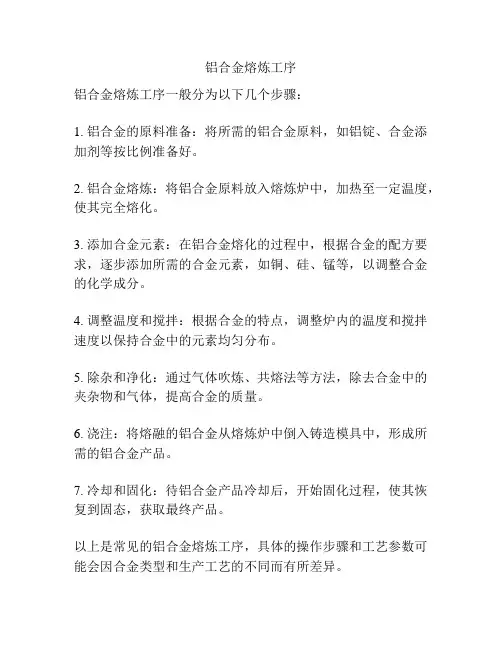
铝合金熔炼工序
铝合金熔炼工序一般分为以下几个步骤:
1. 铝合金的原料准备:将所需的铝合金原料,如铝锭、合金添加剂等按比例准备好。
2. 铝合金熔炼:将铝合金原料放入熔炼炉中,加热至一定温度,使其完全熔化。
3. 添加合金元素:在铝合金熔化的过程中,根据合金的配方要求,逐步添加所需的合金元素,如铜、硅、锰等,以调整合金的化学成分。
4. 调整温度和搅拌:根据合金的特点,调整炉内的温度和搅拌速度以保持合金中的元素均匀分布。
5. 除杂和净化:通过气体吹炼、共熔法等方法,除去合金中的夹杂物和气体,提高合金的质量。
6. 浇注:将熔融的铝合金从熔炼炉中倒入铸造模具中,形成所需的铝合金产品。
7. 冷却和固化:待铝合金产品冷却后,开始固化过程,使其恢复到固态,获取最终产品。
以上是常见的铝合金熔炼工序,具体的操作步骤和工艺参数可能会因合金类型和生产工艺的不同而有所差异。

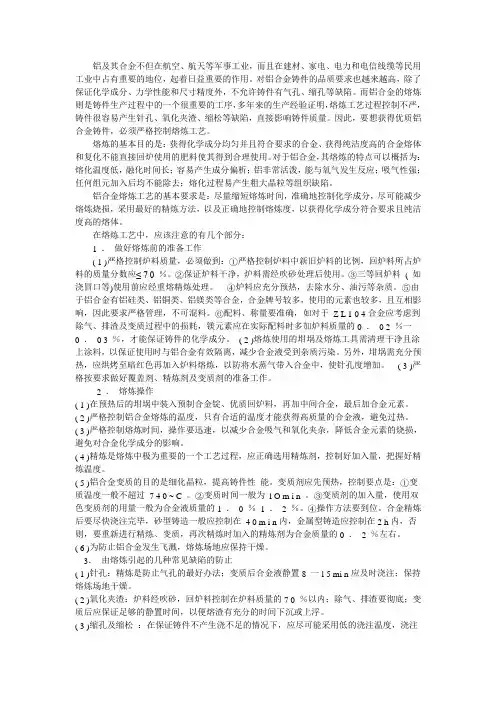
铝及其合金不但在航空、航天等军事工业,而且在建材、家电、电力和电信线缆等民用工业中占有重要的地位,起着日益重要的作用。
对铝合金铸件的品质要求也越来越高,除了保证化学成分、力学性能和尺寸精度外,不允许铸件有气孔、缩孔等缺陷。
而铝合金的熔炼则是铸件生产过程中的一个很重要的工序,多年来的生产经验证明,熔炼工艺过程控制不严,铸件很容易产生针孔、氧化夹渣、缩松等缺陷,直接影响铸件质量。
因此,要想获得优质铝合金铸件,必须严格控制熔炼工艺。
熔炼的基本目的是:获得化学成分均匀并且符合要求的合金、获得纯洁度高的合金熔体和复化不能直接回炉使用的肥料使其得到合理使用。
对于铝合金,其熔炼的特点可以概括为:熔化温度低,融化时间长;容易产生成分偏析;铝非常活泼,能与氧气发生反应;吸气性强;任何组元加入后均不能除去;熔化过程易产生粗大晶粒等组织缺陷。
铝合金熔炼工艺的基本要求是:尽量缩短熔炼时间,准确地控制化学成分,尽可能减少熔炼烧损,采用最好的精炼方法,以及正确地控制熔炼度,以获得化学成分符合要求且纯洁度高的熔体。
在熔炼工艺中,应该注意的有几个部分:1 .做好熔炼前的准备工作( 1 )严格控制炉料质量,必须做到:①严格控制炉料中新旧炉料的比例,回炉料所占炉料的质量分数应≤ 7 0 %。
②保证炉料干净,炉料需经吹砂处理后使用。
③三等回炉料( 如浇冒口等)使用前应经重熔精炼处理。
④炉料应充分预热,去除水分、油污等杂质。
⑤由于铝合金有铝硅类、铝铜类、铝镁类等合金,合金牌号较多,使用的元素也较多,且互相影响,因此要求严格管理,不可混料。
⑥配料、称量要准确,如对于Z L 1 0 4合金应考虑到除气、排渣及变质过程中的损耗,镁元素应在实际配料时多加炉料质量的0 .0 2 %一0 .0 3 %,才能保证铸件的化学成分。
( 2 )熔炼使用的坩埚及熔炼工具需清理干净且涂上涂料,以保证使用时与铝合金有效隔离,减少合金液受到杂质污染。
另外,坩埚需充分预热,应烘烤至暗红色再加入炉料熔炼,以防将水蒸气带入合金中,使针孔度增加。
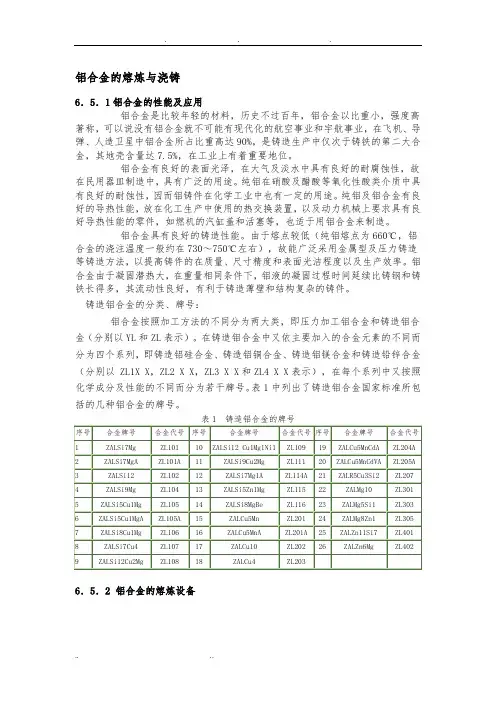
铝合金的熔炼与浇铸6.5.1铝合金的性能及应用铝合金是比较年轻的材料,历史不过百年,铝合金以比重小,强度高著称,可以说没有铝合金就不可能有现代化的航空事业和宇航事业,在飞机、导弹、人造卫星中铝合金所占比重高达90%,是铸造生产中仅次于铸铁的第二大合金,其地壳含量达7.5%,在工业上有着重要地位。
铝合金有良好的表面光泽,在大气及淡水中具有良好的耐腐蚀性,故在民用器皿制造中,具有广泛的用途。
纯铝在硝酸及醋酸等氧化性酸类介质中具有良好的耐蚀性,因而铝铸件在化学工业中也有一定的用途。
纯铝及铝合金有良好的导热性能,放在化工生产中使用的热交换装置,以及动力机械上要求具有良好导热性能的零件,如燃机的汽缸盖和活塞等,也适于用铝合金来制造。
铝合金具有良好的铸造性能。
由于熔点较低(纯铝熔点为660℃,铝合金的浇注温度一般约在730~750℃左右),故能广泛采用金属型及压力铸造等铸造方法,以提高铸件的在质量、尺寸精度和表面光洁程度以及生产效率。
铝合金由于凝固潜热大,在重量相同条件下,铝液的凝固过程时间延续比铸钢和铸铁长得多,其流动性良好,有利于铸造薄壁和结构复杂的铸件。
铸造铝合金的分类、牌号:铝合金按照加工方法的不同分为两大类,即压力加工铝合金和铸造铝合金(分别以YL和ZL表示)。
在铸造铝合金中又依主要加入的合金元素的不同而分为四个系列,即铸造铝硅合金、铸造铝铜合金、铸造铝镁合金和铸造铅锌合金(分别以 ZL1X X,ZL2 X X,ZL3 X X和ZL4 X X表示),在每个系列中又按照化学成分及性能的不同而分为若干牌号。
表1中列出了铸造铝合金国家标准所包括的几种铝合金的牌号。
6.5.2 铝合金的熔炼设备合金熔炼的目的是要获得符合一定成分和温度要求的金属熔液。
不同类型的金属,需要采用不同的熔炼方法及设备。
如钢的熔炼是用转炉、平炉、电弧炉、感应电炉等;铸铁的熔炼多采用冲天炉;而非铁金属铝合金的熔化通常采用坩埚电阻炉,炉子的大小一般为30-500kg,电热体有金属(铁铬合金)、非金属(碳化硅)两种,是广泛用来熔化铝合金的炉子,优点是:炉气呈中性,金属也不会强烈氧化,炉温便于控制,操作简单,劳动条件好。
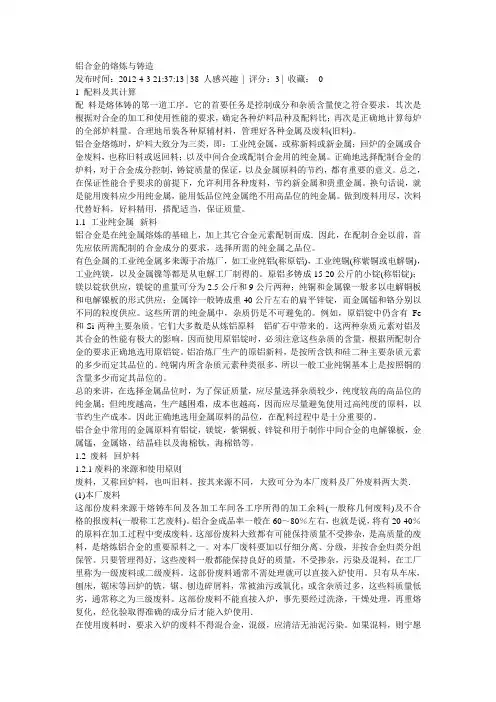
铝合金的熔炼与铸造发布时间:2012-4-3 21:37:13 | 38 人感兴趣| 评分:3 | 收藏:01 配料及其计算配料是熔体铸的第一道工序。
它的首要任务是控制成分和杂质含量使之符合要求,其次是根据对合金的加工和使用性能的要求,确定各种炉料品种及配料比;再次是正确地计算每炉的全部炉料量。
合理地吊装各种原辅材料,管理好各种金属及废料(旧料)。
铝合金熔炼时,炉料大致分为三类,即:工业纯金属,或称新料或新金属;回炉的金属或合金废料,也称旧料或返回料;以及中间合金或配制合金用的纯金属。
正确地选择配制合金的炉料,对于合金成分控制,铸锭质量的保证,以及金属原料的节约,都有重要的意义。
总之,在保证性能合乎要求的前提下,允许利用各种废料,节约新金属和贵重金属。
换句话说,就是能用废料应少用纯金属,能用低品位纯金属绝不用高品位的纯金属。
做到废料用尽,次料代替好料,好料精用,搭配适当,保证质量。
1.1 工业纯金属--新料铝合金是在纯金属熔炼的基础上,加上其它合金元素配制而成.因此,在配制合金以前,首先应依所需配制的合金成分的要求,选择所需的纯金属之品位。
有色金属的工业纯金属多来源于冶炼厂,如工业纯铝(称原铝),工业纯铜(称紫铜或电解铜),工业纯镁,以及金属镍等都是从电解工厂制得的。
原铝多铸成15-20公斤的小锭(称铝锭);镁以锭状供应,镁锭的重量可分为2.5公斤和9公斤两种;纯铜和金属镍一般多以电解铜板和电解镍板的形式供应;金属锌一般铸成重40公斤左右的扁平锌锭,而金属锰和铬分别以不同的粒度供应。
这些所谓的纯金属中,杂质仍是不可避免的。
例如,原铝锭中仍含有Fe 和Si两种主要杂质。
它们大多数是从炼铝原料---铝矿石中带来的。
这两种杂质元素对铝及其合金的性能有极大的影响,因而使用原铝锭时,必须注意这些杂质的含量,根据所配制合金的要求正确地选用原铝锭。
铝冶炼厂生产的原铝新料,是按所含铁和硅二种主要杂质元素的多少而定其品位的。
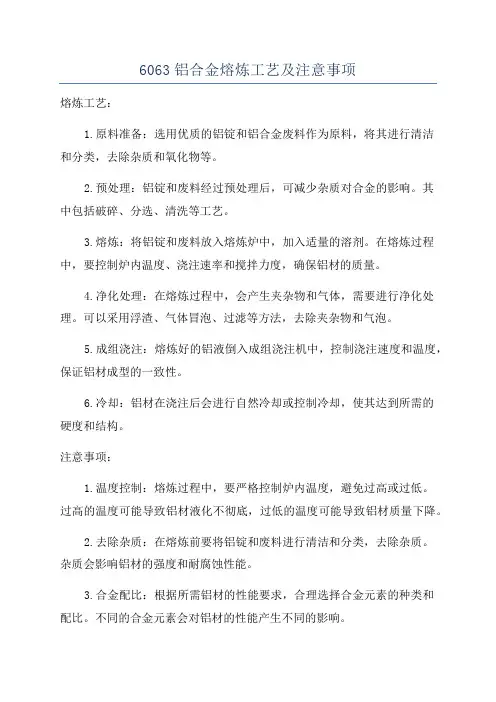
6063铝合金熔炼工艺及注意事项熔炼工艺:1.原料准备:选用优质的铝锭和铝合金废料作为原料,将其进行清洁和分类,去除杂质和氧化物等。
2.预处理:铝锭和废料经过预处理后,可减少杂质对合金的影响。
其中包括破碎、分选、清洗等工艺。
3.熔炼:将铝锭和废料放入熔炼炉中,加入适量的溶剂。
在熔炼过程中,要控制炉内温度、浇注速率和搅拌力度,确保铝材的质量。
4.净化处理:在熔炼过程中,会产生夹杂物和气体,需要进行净化处理。
可以采用浮渣、气体冒泡、过滤等方法,去除夹杂物和气泡。
5.成组浇注:熔炼好的铝液倒入成组浇注机中,控制浇注速度和温度,保证铝材成型的一致性。
6.冷却:铝材在浇注后会进行自然冷却或控制冷却,使其达到所需的硬度和结构。
注意事项:1.温度控制:熔炼过程中,要严格控制炉内温度,避免过高或过低。
过高的温度可能导致铝材液化不彻底,过低的温度可能导致铝材质量下降。
2.去除杂质:在熔炼前要将铝锭和废料进行清洁和分类,去除杂质。
杂质会影响铝材的强度和耐腐蚀性能。
3.合金配比:根据所需铝材的性能要求,合理选择合金元素的种类和配比。
不同的合金元素会对铝材的性能产生不同的影响。
4.浇注速度控制:控制浇注速度可以影响铝材的凝固结构和性能。
过快的浇注速度可能导致气孔和夹杂物的产生,过慢可能导致铝材凝固不完全。
5.存储和运输:熔炼好的铝材应妥善存储和运输,防止氧化和污染。
可以采取包装、封存等方法,确保铝材的质量。
总结:6063铝合金的熔炼过程需要严格控制原料、温度、杂质和合金配比等因素,以获得高质量的铝材。
在熔炼过程中要保证操作规范、设备正常,严格按工艺要求操作。
只有在科学合理的熔炼工艺下,才能获得优质的6063铝合金材料。
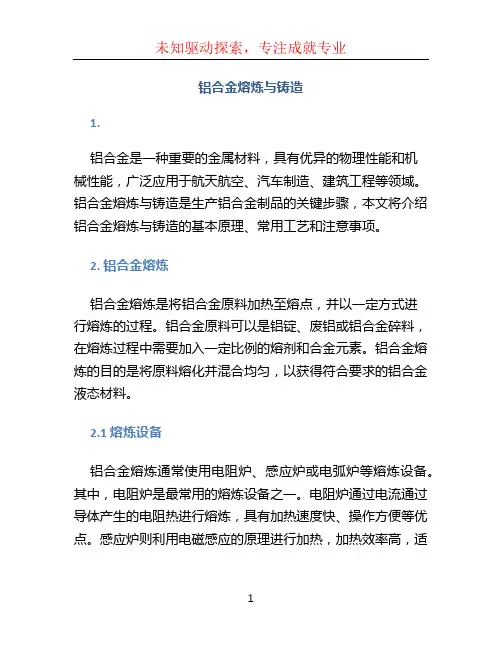
铝合金熔炼与铸造1.铝合金是一种重要的金属材料,具有优异的物理性能和机械性能,广泛应用于航天航空、汽车制造、建筑工程等领域。
铝合金熔炼与铸造是生产铝合金制品的关键步骤,本文将介绍铝合金熔炼与铸造的基本原理、常用工艺和注意事项。
2. 铝合金熔炼铝合金熔炼是将铝合金原料加热至熔点,并以一定方式进行熔炼的过程。
铝合金原料可以是铝锭、废铝或铝合金碎料,在熔炼过程中需要加入一定比例的熔剂和合金元素。
铝合金熔炼的目的是将原料熔化并混合均匀,以获得符合要求的铝合金液态材料。
2.1 熔炼设备铝合金熔炼通常使用电阻炉、感应炉或电弧炉等熔炼设备。
其中,电阻炉是最常用的熔炼设备之一。
电阻炉通过电流通过导体产生的电阻热进行熔炼,具有加热速度快、操作方便等优点。
感应炉则利用电磁感应的原理进行加热,加热效率高,适用于熔炼大批量的铝合金。
电弧炉则利用电弧的高温进行熔炼,适用于熔炼高温合金。
2.2 熔炼工艺铝合金熔炼的工艺通常包括预热、熔炼和保温三个阶段。
将熔炼设备预热至一定温度,然后将铝合金原料和熔剂放入炉中,并控制加热温度和时间,使原料熔化并混合均匀。
,保持一定温度,使铝合金保持液态状态,以备后续的铸造工艺使用。
2.3 熔炼注意事项在铝合金熔炼过程中需要注意以下几点:•安全操作:熔炼过程中需要戴上防护设备,避免接触高温液态金属和有害气体。
•熔化温度控制:严格控制熔化温度,过高的温度会导致铝合金组织不稳定,影响机械性能。
•熔炼时间控制:合适的熔炼时间可以保证原料充分熔化和混合均匀。
•熔剂和合金元素的添加:根据铝合金的要求添加适当比例的熔剂和合金元素,以调整铝合金的成分和性能。
3. 铸造过程铸造是将铝合金液态材料倒入铸型中,并经过凝固和冷却形成所需的铝合金制品的过程。
铸造过程可以分为压铸、重力铸造和砂型铸造等不同的铸造方法。
3.1 压铸压铸是一种通过高压将铝合金液态材料注入金属模具中,并经过快速凝固形成制品的铸造方法。
压铸具有生产效率高、制品精度高等优点,适用于生产复杂形状的铝合金制品。
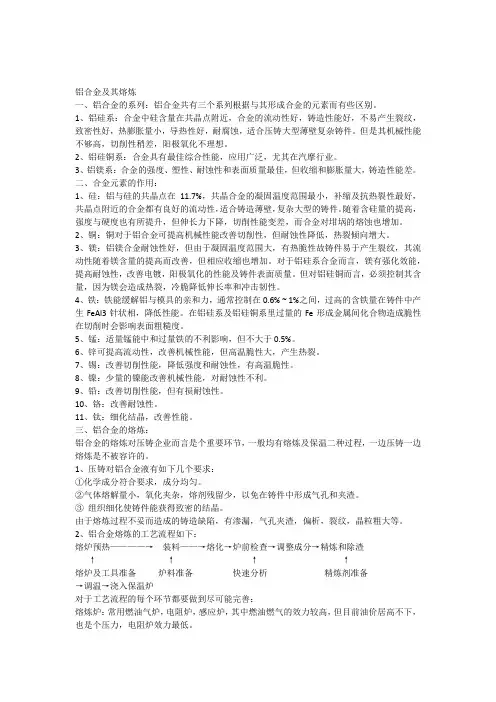
铝合金及其熔炼一、铝合金的系列:铝合金共有三个系列根据与其形成合金的元素而有些区别。
1、铝硅系:合金中硅含量在共晶点附近,合金的流动性好,铸造性能好,不易产生裂纹,致密性好,热膨胀量小,导热性好,耐腐蚀,适合压铸大型薄壁复杂铸件。
但是其机械性能不够高,切削性稍差,阳极氧化不理想。
2、铝硅铜系:合金具有最佳综合性能,应用广泛,尤其在汽摩行业。
3、铝镁系:合金的强度、塑性、耐蚀性和表面质量最佳,但收缩和膨胀量大,铸造性能差。
二、合金元素的作用:1、硅:铝与硅的共晶点在11.7%,共晶合金的凝固温度范围最小,补缩及抗热裂性最好,共晶点附近的合金都有良好的流动性,适合铸造薄壁,复杂大型的铸件。
随着含硅量的提高,强度与硬度也有所提升,但伸长力下降,切削性能变差,而合金对坩埚的熔蚀也增加。
2、铜:铜对于铝合金可提高机械性能改善切削性,但耐蚀性降低,热裂倾向增大。
3、镁:铝镁合金耐蚀性好,但由于凝固温度范围大,有热脆性故铸件易于产生裂纹,其流动性随着镁含量的提高而改善,但相应收缩也增加。
对于铝硅系合金而言,镁有强化效能,提高耐蚀性,改善电镀,阳极氧化的性能及铸件表面质量。
但对铝硅铜而言,必须控制其含量,因为镁会造成热裂,冷脆降低伸长率和冲击韧性。
4、铁:铁能缓解铝与模具的亲和力,通常控制在0.6% ~ 1%之间,过高的含铁量在铸件中产生FeAl3针状相,降低性能。
在铝硅系及铝硅铜系里过量的Fe形成金属间化合物造成脆性在切削时会影响表面粗糙度。
5、锰:适量锰能中和过量铁的不利影响,但不大于0.5%。
6、锌可提高流动性,改善机械性能,但高温脆性大,产生热裂。
7、锡:改善切削性能,降低强度和耐蚀性,有高温脆性。
8、镍:少量的镍能改善机械性能,对耐蚀性不利。
9、铅:改善切削性能,但有损耐蚀性。
10、铬:改善耐蚀性。
11、钛:细化结晶,改善性能。
三、铝合金的熔炼:铝合金的熔炼对压铸企业而言是个重要环节,一般均有熔炼及保温二种过程,一边压铸一边熔炼是不被容许的。
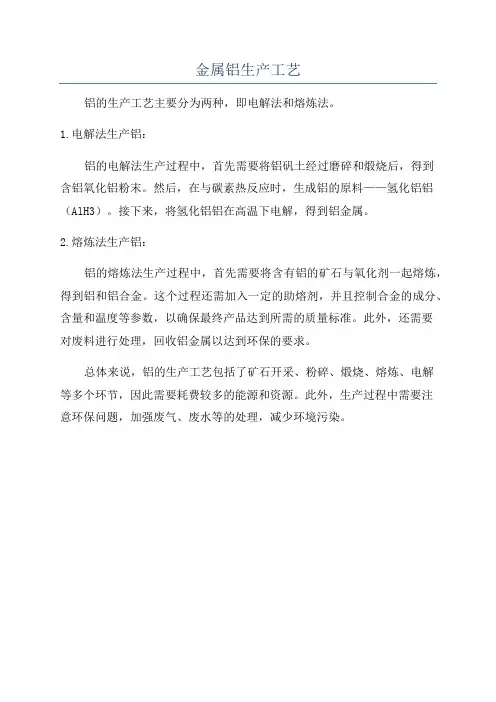
金属铝生产工艺
铝的生产工艺主要分为两种,即电解法和熔炼法。
1.电解法生产铝:
铝的电解法生产过程中,首先需要将铝矾土经过磨碎和煅烧后,得到
含铝氧化铝粉末。
然后,在与碳素热反应时,生成铝的原料——氢化铝铝(AlH3)。
接下来,将氢化铝铝在高温下电解,得到铝金属。
2.熔炼法生产铝:
铝的熔炼法生产过程中,首先需要将含有铝的矿石与氧化剂一起熔炼,得到铝和铝合金。
这个过程还需加入一定的助熔剂,并且控制合金的成分、含量和温度等参数,以确保最终产品达到所需的质量标准。
此外,还需要
对废料进行处理,回收铝金属以达到环保的要求。
总体来说,铝的生产工艺包括了矿石开采、粉碎、煅烧、熔炼、电解
等多个环节,因此需要耗费较多的能源和资源。
此外,生产过程中需要注
意环保问题,加强废气、废水等的处理,减少环境污染。
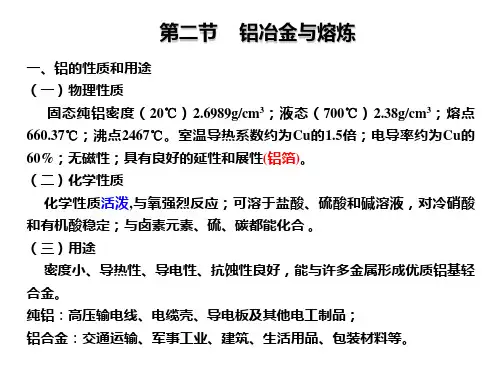
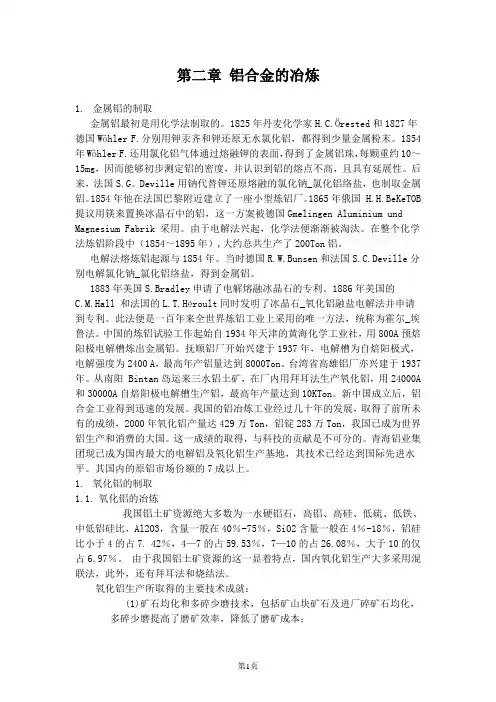
第二章铝合金的冶炼1.金属铝的制取金属铝最初是用化学法制取的。
1825年丹麦化学家H.C.Örested和1827年德国Wöhler F.分别用钾汞齐和钾还原无水氯化铝,都得到少量金属粉末。
1854年Wöhler F.还用氯化铝气体通过熔融钾的表面,得到了金属铝珠,每颗重约10~15mg,因而能够初步测定铝的密度,并认识到铝的熔点不高,且具有延展性。
后来,法国S.G。
Deville用钠代替钾还原熔融的氯化钠_氯化铝络盐,也制取金属铝。
1854年他在法国巴黎附近建立了一座小型炼铝厂。
1865年俄国 H.H.BeKeTOB 提议用镁来置换冰晶石中的铝,这一方案被德国Gmelingen Aluminium und Magnesium Fabrik 采用。
由于电解法兴起,化学法便渐渐被淘汰。
在整个化学法炼铝阶段中(1854~1895年),大约总共生产了200Ton铝。
电解法熔炼铝起源与1854年。
当时德国R.W.Bunsen和法国S.C.Deville分别电解氯化钠_氯化铝络盐,得到金属铝。
1883年美国S.Bradley申请了电解熔融冰晶石的专利。
1886年美国的C.M.Hall 和法国的L.T.Héroult同时发明了冰晶石_氧化铝融盐电解法并申请到专利。
此法便是一百年来全世界炼铝工业上采用的唯一方法,统称为霍尔_埃鲁法。
中国的炼铝试验工作起始自1934年天津的黄海化学工业社,用800A预焙阳极电解槽炼出金属铝。
抚顺铝厂开始兴建于1937年,电解槽为自焙阳极式,电解强度为2400 A,最高年产铝量达到8000Ton。
台湾省高雄铝厂亦兴建于1937年。
从南阳 Bintan岛运来三水铝土矿,在厂内用拜耳法生产氧化铝,用24000A 和30000A自焙阳极电解槽生产铝,最高年产量达到10KTon。
新中国成立后,铝合金工业得到迅速的发展。
我国的铝冶炼工业经过几十年的发展,取得了前所未有的成绩,2000年氧化铝产量达429万Ton,铝锭283万Ton,我国已成为世界铝生产和消费的大国。
铝合金熔炼与铸造技术一、引言铝合金是一种重要的结构材料,具有轻质、高强度和良好的耐腐蚀性能,在航空航天、汽车制造、建筑工程等领域广泛应用。
铝合金的制备过程中,熔炼与铸造技术起到关键作用,本文将对铝合金熔炼与铸造技术进行详细探讨。
二、铝合金熔炼技术2.1 熔炼原料准备熔炼铝合金的原料主要包括铝、合金元素和辅助材料。
铝采用高纯度的铝锭,合金元素可以通过添加铝合金粉末或其他化合物来实现。
辅助材料包括熔剂、脱气剂等。
这些原料的准备对于保证铝合金的成分和质量非常重要。
2.2 熔炼设备和工艺熔炼铝合金的常用设备有电阻加热炉、感应加热炉和气体燃烧炉等。
其中,感应加热炉在铝合金熔炼中应用最广泛,具有加热速度快、能耗低和温度控制准确等优点。
熔炼工艺包括预热、熔化、调温和净化等步骤,其中净化技术对于铝合金的纯净度和性能起到重要作用。
2.3 熔炼过程控制与优化熔炼过程中,熔体温度、保温时间、搅拌方式等因素对铝合金的成分和组织结构有重要影响。
熔炼过程需要进行温度控制、气氛控制和搅拌控制等,以确保铝合金的成分均匀、杂质含量低。
三、铝合金铸造技术3.1 铸造方法铝合金的常用铸造方法包括压铸、重力铸造、低压铸造和砂型铸造等。
压铸是最常用的铸造方法,适用于生产复杂形状和尺寸精度要求高的铝合金件。
重力铸造适用于大型铝合金零部件的生产,低压铸造适用于长条状和壳状铝合金件的生产,砂型铸造适用于非常大型和特殊形状的铝合金件的生产。
3.2 铝合金铸造过程铝合金的铸造过程主要包括熔炼、准备模具、浇注、冷却和后处理等步骤。
熔炼过程中,需要根据具体合金配方和要求,控制熔体温度、浇注温度和浇注速度等参数。
准备模具是确保铸造件尺寸和表面质量的重要环节。
浇注过程需要保证熔体充分填充模腔,并避免气孔和缺陷的产生。
冷却过程中需控制冷却速率,以避免铝合金件出现应力和变形。
3.3 铝合金铸造工艺改进为了提高铝合金铸造件的质量和效率,可以采取一些工艺改进措施。
铝的冶炼方法及工艺报告铝的冶炼方法及工艺报告一、铝的冶炼方法铝的冶炼主要有三种方法:熔融法、电解法和气相法。
1. 熔融法:熔融法是最常用的铝冶炼方法,其包括母铝熔炼和铝合金熔炼两个过程。
母铝熔炼通常使用氧化铝作为原料,通过碳素热还原法或电解还原法将其转化为铝金属。
铝合金熔炼是将纯铝与其他金属元素进行混合加热,使其形成合金。
熔融法具有操作简单、生产效率高、成本较低等优点。
2. 电解法:电解法是较为常用的铝冶炼方法,主要应用于高纯度铝的生产。
电解法是通过在熔融盐中电解氧化铝来制取铝金属。
具体过程为将氧化铝放置在电解槽中,以高温(约960)进行熔化,加入电解盐(如氟化铝钠、氯化铝等)形成电解质。
铝阳极和碳负极在电流作用下反应,最终得到纯铝。
3. 气相法:气相法是一种较新的铝冶炼方法,主要用于高纯度铝的生产。
气相法通过将金属铝的气态化合物(如三氯化铝、铝烷等)从炉中蒸发,并通过化学反应和凝结过程将其分离和回收,最终得到高纯度的铝金属。
气相法具有生产过程封闭、环境友好、能耗低等优势。
二、铝的冶炼工艺铝的冶炼工艺主要包括矿石选矿、矿石研磨、氧化铝还原、电解铝和铝合金制备等过程。
1. 矿石选矿:铝矿石一般以高含铝氧化铝矿石为主,如莫来石、赤凹石等。
在选矿过程中,通过破碎、筛分和重选等方法,将石头和其他有用矿物分离。
2. 矿石研磨:选矿后的铝矿石需要进行研磨,通常采用球磨机对矿石进行细磨,以提高其可浸出性。
3. 氧化铝还原:氧化铝还原是母铝熔炼的关键步骤。
通常采用碳素热还原法或电解还原法将氧化铝转变为铝金属。
碳素热还原法是将氧化铝与电解炭混合,加热至高温(约2000)进行反应;电解还原法是通过在熔融盐中进行电解反应,最终得到纯铝。
4. 电解铝:电解铝是通过电解法制取高纯度铝金属的过程。
在电解槽中,将氧化铝置于熔融盐中,通过电流的作用,使铝阳极与碳负极产生化学反应,最终得到纯铝。
5. 铝合金制备:铝合金制备是将纯铝与其他金属元素混合加热,使其形成合金。
铝合金的熔炼与铸造(Melting and casting of aluminum alloy)Melting and castingMelting and pouring of aluminum alloy is the main link in casting production. The whole process of melting and casting is strictly controlled, which plays an important role in preventing casting defects such as pinholes, inclusions, castings, cracks, porosity and shrinkage. Because the aluminum melt absorbs the hydrogen tendency, the oxidation ability is strong, dissolves the iron easily, in smelting and the casting process, must take the simple and careful preventive measure, obtains the high-quality casting.1 、 preparation and quality control of aluminum alloy burdenIn order to smelt high quality aluminum melt, the qualified raw material should be selected first. To carry out scientific management and proper processing of raw materials, otherwise it will seriously affect the quality of the alloy, the production practice has proved that the raw materials (including metal materials and auxiliary materials) lax control will make batch scrap castings.(1) raw materials must have qualified chemical composition and organization, and the specific requirements are as follows:In addition to the analysis of the main components and impurities in the alloy ingots, the microstructure and fracture of the alloy were examined. Practice has proved that the use of serious shrinkage cavity, pinhole, and bubbles of aluminum liquid, it is difficult to obtain dense castings, and even causethe whole furnace, batch castings scrapped.It was found in the study of Al Si alloy ingots of Aluminum Alloy pinhole, does not appear in the molten pure sand casting pinhole test block, when the aluminum silicon alloy ingot with low and unqualified specimens, pinhole serious, and the grain size large. The reason is the heredity of the material. The heredity of Al Si alloy and heredity increased with the increase of content and the amount of silicon reached 7%. Continue to increase silicon content to eutectic component, heredity decreases slightly again. In order to solve the casting defects caused by the heredity of the burden, aluminum ingots, intermediate alloys and other charging materials with high metallurgical quality must be selected. Specific standards are as follows:(1) there should be no pinholes or holes in the fracture surfacePinhole shall be within grade three, and local (not exceeding 25% of the inspected area) shall not exceed three grade. Over three grade shall be taken by means of heavy smelting to reduce the degree of puncture. Remelting refining method and the general Aluminum Alloy smelting, casting temperature should not exceed 660 degrees, for the original grain large aluminum ingot, alloy ingot, should be the first to use the lower mold temperature, making them rapid solidification, grain refinement.2 、 burden treatmentBefore using the burden, it should be treated by blowing sandto remove the surface rust, grease and other dirt. The time is not long, Aluminum Alloy ingot and metal scrap surface is clean without blowing sand, but should be in charge of the elimination of mixed iron filters and inserts, all shall be in charge of preheating furnace, to remove the surface of the water, shorten the melting time in 3 hours above.3 、 management and storage of burdenReasonable storage and management of burden is important to ensure the quality of alloy. The burden shall be stored in a dry warehouse with little change in temperature.2 、 preparation of crucible and melting tools(1) crucible casting aluminum alloy commonly used iron crucible, also can use cast steel and steel plate welding crucible.New and old is not for a long time in the crucible crucible, before use should be blowing sand, and heated to 700--800 degrees, to keep 2--4 hours, to burn water and attached to the inner wall of the crucible of combustible material, to be cooled to 300 degrees below, carefully clean the inside of the crucible, at a temperature not lower than 200 degrees when spraying paint.The crucible should be preheated to dark red (500--600 degrees) before use and kept warm for more than 2 hours. Before the new outer crucible melting, melting scrap with the best grades of a furnace.(two) preparation of smelting toolsZhong Zhao, press ladle, mixing spoon, ladleAt the other before use shall be preheated, and at 150 degrees ---200 degrees temperature, coated with a protective coating, and thorough drying, the drying temperature is 200--400 degrees, holding time of 2 hours, after use should be thoroughly removed attached on the surface of oxide and fluoride (preferably blowing sand).3, smelting temperature controlThe melting temperature is too low, is not conducive to the dissolution of alloying elements and gas inclusions, discharge, tendency segregation, cold shut, undercasting increase formation, but also because of insufficient heat riser, the casting without reasonable feeding, has information that,The melting temperature of all aluminum alloys should be up to 705 degrees and should be stirred. The melting temperature is too high, not only a waste of energy, more serious is because the higher the temperature, the hydrogen absorption of the grain becomes thick, aluminum oxide is more serious, some of the burning loss of alloy elements is more serious, which leads to a decrease in the mechanical properties of the alloy, casting the deterioration of mechanical properties and modification, weaken the effect of air the castings reduce.The production practice shows that the molten alloy rapid heating to high temperature, reasonable stirring to dissolve all alloy elements (especially refractory metals), scrapingscum down after the pouring temperature, so that the minimum degree of segregation, melting of hydrogen is less favorable, to obtain the uniform and compact alloy mechanical properties high. Because the aluminum melt temperature is difficult to determine with the naked eye, so no matter what type of the melting furnace, should use temperature control instrument. The instrument should be regularly checked and the maintenance cycle should thermowell with metal brush clean, coated with a protective coating, in order to ensure the accuracy and prolong the service life of the measurement result.4 、 control of smelting timeIn order to reduce the oxidation, gettering and dissolution of molten aluminum, the residence time and rapid melting of molten aluminum should be shortened. From the beginning of the melt to the end of the casting, the sand casting shall not exceed 4 hours, the die casting shall not exceed 6 hours, and the die casting shall not exceed 8 hours.In order to speed up the smelting process, should first join the scrap aluminum silicon intermediate alloy medium size, low melting point, in order to accompany the formation of molten pool as soon as possible in the crucible bottom, then add the returns for larger pieces and pure aluminum ingot, so that they can gradually expand slowly immersed in molten pool, fast melting. When the main part of the furnace is melted, the intermediate alloy with higher melting point and small quantity is melted and stirred to accelerate the melting. Finally, cool down and press the oxidizable alloy elements to reduce the loss.5, melt transfer and pouringAlthough the density of the solid alumina is similar to the density of the aluminum melt, it will take a long time to sink to the bottom of the crucible after entering the interior of the molten aluminum. Alumina film is oxidized and aluminum melt formation, but only in contact with the molten aluminum side is dense, and exposed to the air side loose and there is a lot of 60--100A diameter holes, its large surface area, strong adsorption, easy adsorption in water vapor, the tendency of anti floating. Therefore, in this film and aluminum melt proportion difference is small, be mixed with the melt, and the speed is very slow, it is difficult to exclude from the melt, porosity inclusion formation in castings too. Therefore, the key to transfer aluminum melt is to minimize the agitation of molten metal and minimize the contact between the melt and the air.By tilting the crucible melt injection, in order to avoid mixing melt and air, should be as far as possible by the ladle furnace nozzle, and inclined, melt down along the side wall of the ladle, no direct impact on the bottom of the bag, occurrence of agitation, splash.The proper and reasonable pouring method is one of the important conditions to obtain high quality castings. In the production practice, it is effective to prevent and reduce casting defects by paying attention to the following items.(1) the temperature of the melt, the capacity of the ladle and the degree of dryness of the coating on the surface shall beexamined carefully before pouring, and whether the preparation of other tools meets the requirements or not. The metal gate Cup before casting 3--5 minutes in the sand on a good place, the ladle with the temperature less than 150 degrees for premature or excessive temperature, pouring tract hold large amounts of gas, there is a danger of explosion when pouring.(two) not in the "draught" casting occasions, as well as strong melt oxidation, combustion, the casting defects such as oxide inclusions.(three) obtained by melt in the crucible, should first use of bottom oxide layer or the flux through gently melt surface, slowly immersed in the melt with the ladle, ladle a wide mouth melt, and then gently lift the ladle.(four) the end of the package should not be flat; the pace should be steady; the ladle should not be raised too high; the metal level in the ladle must be stable and free from movement.(five) to be cast, with net ladle slag should be,In order to avoid pouring slag, oxide, etc. into the mold.(six) in the casting, the melt flow is stable, can not be interrupted, not into the mouth with the bottom. Sprue should be full from beginning to end, liquid level shall not turn, casting speed should be properly controlled. Usually, the casting starts slightly slower, filling the melt, stabilizing it, then slightly faster, and keeping the casting speed constant.(seven) in the pouring process, pouring ladle and gate distance as close as possible, not more than 50 mm limit, so as not to melt too much oxidation.(eight) with a blocked gate, the plug cannot be dialed too early. After the melt has filled the gate, it is slowly tilted out so as to prevent the melt from producing eddy current when it is injected into the sprue.(nine) the melt less than 60 mm from the bottom of the crucible shall not be poured into the casting.Aluminum alloy casting (ZL)According to the main elements other than aluminum, silicon, copper, magnesium and zinc are divided into four kinds, and the codes are 100, 200, 300 and 400 respectively.In order to obtain high quality precision castings of various shapes and specifications, aluminum alloys for casting usually have the following characteristics.(1) a narrow slot filled with good liquidity part(2) there is a melting point lower than that of a general metal, but it can meet most of the requirements(3) the thermal conductivity is good, the heat of molten aluminum can be transferred rapidly to the mold, and the casting cycle is shorter(4) hydrogen and other harmful gases in the melt can be effectively controlled by treatment(5) Aluminum Alloy casting, no cracking and tearing cracking tendency(6) good chemical stability and strong corrosion resistance(7) it is not easy to produce surface defects, the casting surface has good surface finish and gloss, and easy to surface treatment(8) Aluminum Alloy casting processing performance is good, can die, die, sand and dry sand mold, gypsum type casting casting, vacuum casting, can also be used for low and high pressure casting, extrusion casting, semi-solid casting, centrifugal casting forming method, with different purposes, different varieties of production specifications and different properties of various castings.Cast aluminum alloy has been widely used in cars, such as cylinder head, intake manifold, piston, wheel hub, steering booster housing, etc.。
铝冶金讲义一、引言铝是一种重要的金属材料,广泛应用于工业、建筑、交通等领域。
铝冶金是指将铝矿石中的铝氧化物还原为金属铝的过程。
本文将从铝冶金的原理、工艺和应用等方面进行介绍。
二、铝冶金的原理铝冶金主要依靠铝氧化物还原反应来实现。
常用的还原剂有焦炭、石油焦和天然气等。
还原反应的化学方程式如下:2Al2O3 + 3C → 4Al + 3CO2三、铝冶金的工艺1. 铝矿石的选矿:首先需要对铝矿石进行选矿,去除其中的杂质,提高铝的纯度。
2. 熔炼:将经过选矿处理的铝矿石与还原剂一起放入电解炉或熔炼炉中,进行熔炼。
在高温下,还原剂与铝氧化物发生反应,生成金属铝。
3. 精炼:经过熔炼后的铝还需要进行精炼,去除其中的杂质,提高铝的纯度。
4. 凝固:将精炼后的铝液注入模具中,冷却凝固,形成铝锭或铝板等产品。
四、铝冶金的应用1. 工业:铝是一种轻便、耐腐蚀的金属,广泛应用于飞机、汽车、船舶等制造业。
同时,铝也是电力、电子、包装等行业的重要材料。
2. 建筑:铝合金具有优异的强度和耐候性,被广泛应用于建筑领域,如门窗、幕墙、铝合金板材等。
3. 交通:铝合金轻便、耐腐蚀,被广泛应用于汽车、火车、自行车等交通工具的制造中,可以减轻车辆重量,提高燃油效率。
4. 包装:铝是一种优良的包装材料,可以用于制作易拉罐、药品包装等,具有良好的密封性和保鲜性。
五、铝冶金的发展趋势1. 绿色环保:铝冶金过程中会产生大量的二氧化碳排放,对环境造成一定的影响。
未来的铝冶金将更加注重绿色环保,采用清洁能源和环保技术来减少碳排放。
2. 节能减排:铝冶金是一种能耗较高的工艺,未来的发展将更加注重节能减排,提高能源利用效率。
3. 创新技术:随着科技的进步,新的铝冶金技术不断涌现。
例如,电解铝技术、气体还原技术等,都在不断改善冶金工艺,提高铝的生产效率和质量。
六、结论铝冶金是一项重要的工业技术,对于现代社会的发展起到了关键作用。
随着技术的不断进步和需求的增加,铝冶金将迎来更广阔的发展前景。
冶金有色金属熔炼铝灰综合利用处理探析发布时间:2021-10-19T08:06:12.645Z 来源:《城镇建设》2021年第5月15期作者:邓建平[导读] 冶金有色金属铝冶炼压延加工行业既是高耗能行业又是高污染行业,邓建平(四川自贡 643000)摘要:冶金有色金属铝冶炼压延加工行业既是高耗能行业又是高污染行业,产生的固废对环境有较大污染。
金属熔炼铝的生产过程中会产生大量铝灰渣和二次铝灰。
若铝灰不经处理直接废弃,既污染环境又会给企业带来巨大经济损失。
本文从铝行业发展循环经济、绿色经济、综合利用的角度从出发,介绍了从铝灰、二次铝灰产生来源,从铝灰的危害和资源无害化资源利用进行探讨介绍。
如何实现固危废的无害化环保综合利用,即避免污染环境,又为企业创造经济效益,是铝行业发展循环经济、绿色经济,实现可持续发展的重要任务之一。
关键词:铝灰;有色金属;冶金;综合利用;无害化;1.引言有色金属铝冶炼压延加工行业既是高耗能行业又是高污染行业,产生的固废对环境有较大污染。
有色冶炼铝企业如何实现固废的无害化综合利用,即避免污染环境,又创造经济效益,是铝行业发展循环经济、绿色经济,实现可持续发展的重要任务之一。
2.铝灰的概念铝灰是电解铝或铸造铝生产工艺中产生的熔渣经冷却加工后的产物,其主要成分为氧化铝,三氧化二铝和二氧化硅等。
不同来源的铝灰成分会有所差别,按照金属原料的来源可分为以下四类。
(1)电解铝铝灰:以液态电解铝水为原料,采用短流程熔炼工艺生产的铝锭、铝棒、铝板带、铝杆等铸锭坯料,在熔炼工序中产生的固体废弃物。
(2)熔铸铝灰:以重熔铝锭为原料,经过熔炼工艺生产铝锭、铝棒、铝板带、铝杆等铸锭坯料,在熔炼工序中产生的固体废弃物。
(3)再生铝铝灰:以回收的各类铝制品、混合铝切片、机加工铝屑等为原料,经过熔炼工艺生产铝锭、铝棒、铝板带、铝杆等铸锭坯料,在熔炼工序中产生的固体废弃物。
(4)其他:所有铝工业生产中产生的主要成分为金属铝、氧化铝的固体废料,如电解铝抬包清理料,熔炼炉清炉料,熔炼炉烟气净化收尘粉。
铝合金熔炼工艺流程和操作工艺(一)装料熔炼时,装入炉料的顺序和方法不仅关系到熔炼的时间、金属的烧损、热能消耗,还会影响到金属熔体的质量和炉子的使用寿命。
装料的原则有:1、装炉料顺序应合理。
正确的装料要根据所加入炉料性质与状态而定,而且还应考虑到最快的熔化速度,最少的烧损以及准确的化学成分控制。
装料时,先装小块或薄片废料,铝锭和大块料装在中间,最后装中间合金。
熔点易氧化的中间合金装在中下层。
所装入的炉料应当在熔池中均匀分布,防止偏重。
小块或薄板料装在熔池下层,这样可减少烧损,同时还可以保护炉体免受大块料的直接冲击而损坏。
中间合金有的熔点高,如AL-NI和AL-MN合金的熔点为750- 800C,装在上层,由于炉内上部温度高容易熔化,也有充分的时间扩散;使中间合金分布均匀,则有利于熔体的成分控制。
炉料装平,各处熔化速度相差不多这样可以防止偏重时造成的局部金属过热。
炉料应进量一次入炉,二次或多次加料会增加非金属夹杂物及含气量。
2、对于质量要求高的产品(包括锻件、模锻件、空心大梁和大梁型材等)的炉料除上述的装料要求外,在装料前必须向熔池内撒20-30kg粉状熔剂,在装炉过程中对炉料要分层撒粉状熔剂,这样可提高炉体的纯洁度,也可以减少损耗。
3、电炉装料时,应注意炉料最高点距电阻丝的距离不得少于100mm,否则容易引起短路。
炉料装完后即可升温。
熔化是从固态转变为液态的过程。
这一过程的好坏,对产品质量有决定性的影响。
A、覆盖时,应适当向金属表面撒上一层粉状熔剂覆盖,其用量见表。
这样也可以减少熔化过程中的金 炉型及制品 电气熔炼覆盖剂用量 普通制品特殊制品(占投量)/%0.4-0.5 覆盖剂种类 粉状熔剂煤气炉熔炼普通制品特殊制品 0.5-0.61-2 2-4 Kcl : Nacl 按 1 : 1 混合 当炉料熔化一部分后,即可向液体中均匀加入锌锭或铜板,以熔池中的熔体刚好能淹没住锌 很容易破裂,将逐渐失去保护作用。